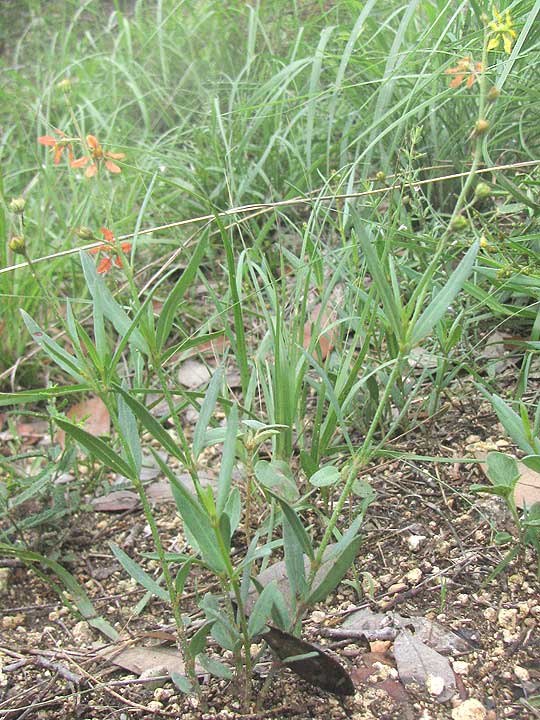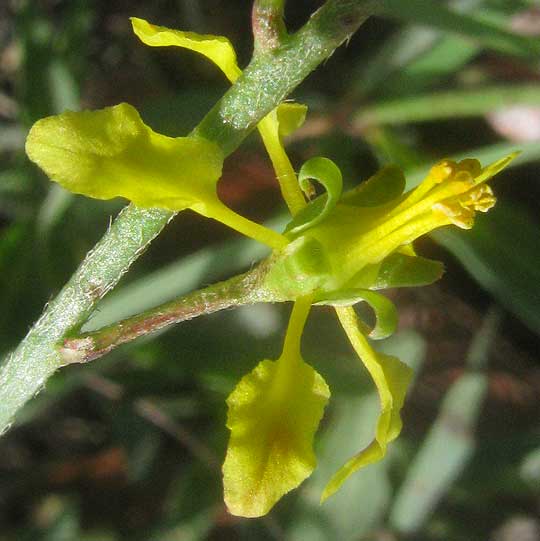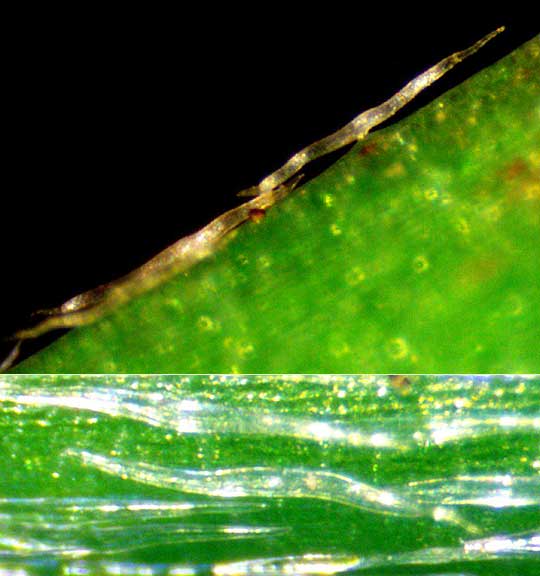Excerpts from Jim Conrad's
Naturalist Newsletter
from the June 23, 2013 Newsletter issued from the Frio Canyon Nature Education Center in the valley of the Dry Frio River in northern Uvalde County, southwestern Texas, on the southern border of the Edwards Plateau; elevation ~1750m (~5750 ft); N29.62°, W99.86°; USA
GOLDSHOWER
At the edge of the new nature center's dirt parking lot where bare dirt gives way to spotty grass, Phred noticed a foot-tall herb bearing flowers that were about half an inch across (13mm), and with yellow and reddish blossoms on the same plant. The plant, whose young shoots arose from a woody base, was so well camouflaged in the grass that it was hard to see, as you can confirm below:

On hands and knees it was clear that this was something unusual, for the flowers' anatomy didn't match that of any of our usual plant families. For instance, though the flowers had petals and calyx lobes in fives, which is very normal, they bore eight stamens. And the stamens were slightly bent downward, causing the flower to have bilateral symmetry, not the usual radial. A yellow flower appears below:

The capsular fruits were three-lobed, which is a bit unusual, as shown below:

At first I was stymied, but then my hand lens picked up something else that was unusual. The plant's tiny hairs, which lay close to the plant body, were attached to the plant at their middles. They were structured like Ts with very short bottom parts. You can see two pictures of these hairs as seen through a dissecting scope below:

In that picture the top image is a side view of two hairs on the stem. Can you see how the hair at the top, right attaches to the stem at its center, while its two ends form sharp spears pointing in opposite directions? The lower image shows hairs on a leaf. Notice that the hair in the center has two pointed ends.
Botanists know such hairs as "malpighian" or "dolabriform" hairs. The word malpighian derives from the mostly tropical-American Malpighia Family of plants, the Malpighiaceae, because species in that family often are clothed with malphighian hairs.
Remembering this, it occurred to me that during recent years we've seen flowers structured like our mysterious parking-lot denizen fairly regularly in the Mexican tropics. For example, look at the Barbados Cherry blossom at http://www.backyardnature.net/yucatan/barbados.htm.
And the Nance at http://www.backyardnature.net/yucatan/nance.htm.
Both the Barbados Cherry and Nance are members of the Malpighia Family.
When I checked if any members of the Malpighia Family occur in southwestern Texas, I found a few, and from that short list it was easy to figure out that our mystery plant was GALPHIMIA ANGUSTIFOLIA, listed in wildflower books as the Narrow-leaf Goldshower or Thryallis. Mostly the species occurs in arid northern Mexico but it extends into the US in a handful of counties here in southwestern Texas.
The genus Galphimia with its 26 species occurs only in tropical and subtropical parts of the Americas. Its center of evolution -- where the most species are -- is in Mexico, and our Narrow-leaf Goldshower is the only one that extends into the US. Here its habitat is described as open, rocky or lightly wooded areas on the Edwards Plateau, which is exactly where we found it. Also it specializes in dry, thin soil atop limestone, and caliche soils, just like ours.